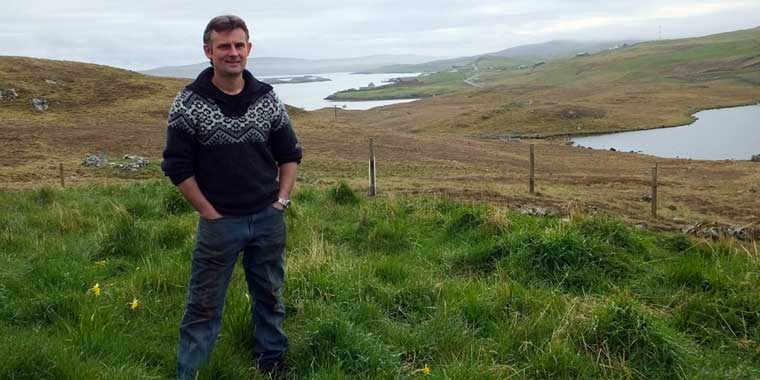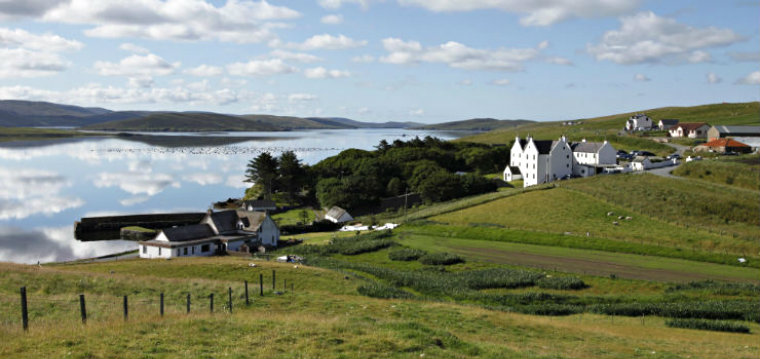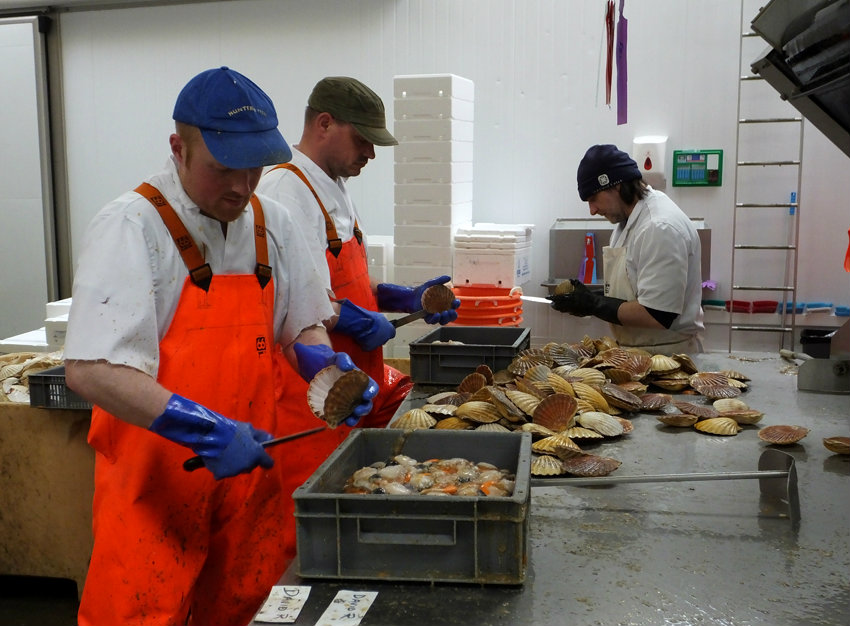Here’s one I rescued earlier
Elizabeth Atia, RNLI volunteer and Britain’s most northerly food blogger, is shown the ropes of scallop dredging by the skipper she helped haul from the rocks a year before.

Last May, very late on a Saturday night after a long, busy day, I dozed off while reading a book on the couch. Moments later I was abruptly woken by the piercing sound of my RNLI pager: a Launch ALB request from the Shetland Coastguard.
The sound of the pager is like a shot of adrenaline straight to the heart; it doesn’t matter how tired you are you suddenly find yourself poised and alert. My husband and children were fast asleep in their beds upstairs and didn’t hear me quickly leave the house.
It was pitch black when Britain’s most northerly all-weather RNLI lifeboat, the Charles Lidbury, left the Aith pier with its crew of volunteers. The sea was like glass; there wasn’t a hint of a breeze. We were briefed that a scallop dredger had run aground on the west coast of Shetland and it was listing dangerously as the tide ebbed.

This is where I met scallop dredger and skipper of the Marea B, Malcolm Robertson. He had been returning from a day’s dredging when he was taken by surprise by an unlit set of mussel ropes. He quickly took evasive action and went zig instead of zag, stranding himself on rocks in shallow water.
When the two crew were safely onboard the lifeboat we warmed ourselves with hot coffee as dawn broke. That was the best cup of coffee I’ve ever had, fingers warming on the outside of the mug, our breath visible in the cool morning air. We listened to the men tell fishing stories while we waited for the tide to come back in so we could refloat the boat.
A year later Malcolm and I drank coffee and swapped stories again, but this time it was in comfort at his kitchen table.
Malcolm comes from a long line of Shetland born and bred fisherman/crofters. He grew up next to the seashore and learned how to row a boat long before he learned how to pedal a bicycle. He always thought, as a child, he’d go to the fishing when he grew up, just like his father.

It’s been a lifelong dream of Malcolm’s to have his own boat. He’d fished for others and trained as a salmon farmer at college but just over two years ago he realised he wasn’t getting any younger and so he just went for it: he bought the Marea B and began scallop dredging.
“It’s hard work,” says Malcolm, “but you’re your own boss. It’s the freedom of it: the open sea, the fresh air.”
Scallop dredgers have received a considerable amount of bad press over the years with the environmental damage they can cause, but Malcolm’s boat is different. It’s small, for a start, and he uses a new N-Viro Dredge instead of the traditional dredge: it uses flexible spring tines instead of metal teeth, so it’s gentler on the seabed, and it’s lighter too so it’s more fuel efficient. It also causes less damage to the scallops themselves, improving the yield of each tow.
Malcolm’s boat is one of at least four in Shetland using this new dredge. At the end of a long day fishing his catch is landed at the nearest pier where Blueshell Mussels is waiting to collect and process it.
The family owned Blueshell Mussels, based in Brae, Shetland, is the UK’s leading rope-grown mussel farmer, but they also process and pack crab and king scallops. The scallops are landed fresh daily by a number of small inshore vessels, including the Marea B, which are all part of the Shetland Shellfish Management Organisation (SSMO).

In March 2012 the SSMO Shetland inshore scallop fishery became the world’s first king scallop fishery to gain MSC certification. This was achieved through the efforts of the North Atlantic Fisheries College (NAFC), which carefully manages Shetland inshore waters. A scallop permit is required to dredge within 6 nautical miles of Shetland, and it is only permitted within certain hours and with a specific number of dredges per tow. The activities of a limited number of boats are carefully monitored by the NAFC.
“Shetland may be pioneering sustainability,” says Michael Laurenson, owner of Blueshell Mussels. “People care about the environment – including their carbon footprint, so the boats are being upgraded to be more fuel efficient.
“As a small fishing community we are dependent on the sea. Fisherman are aware of preserving these shores and stocks for future generations. Smaller boats limit the damage they can cause, and they move around, allowing the seabed time to recover.”

Blueshell Mussels supply Frankie’s, Scotland’s #1 fish and chip shop, located a few minutes up the road from them, with MSC certified mussels, crab and scallops. They also supply the Busta House Hotel & Restaurant in Brae.
Busta House, situated on the picturesque Busta Voe, is Shetland’s longest continually inhabited building, with parts of it dating back to the 16th century. I recently paid them a visit to have my very first taste of scallops, prepared by chef Daniel Okroj.
“It is important for us to promote the healthy eating and fresh food image which Shetland is renowned for, and Blueshell Mussels always deliver the freshest produce,” says Veronica Rocks, the owner of Busta House. “The local fisherman are our neighbours. We trust their judgement and skills. And by working together with local producers we can help sustain our island economy for future generations.”
Busta House has very kindly provided the recipe for the delicious pan-seared scallops and langoustines with stir fried vegetables that I had the great pleasure of eating during my visit. Click here to see the recipe. Elizabeth Atia is a food blogger living in Shetland. She has a passion for local produce and enjoys researching and sharing the stories behind the ingredients and recipes she cooks on her blog at Elizabeth’s Kitchen Diary .
Elizabeth Atia is a food blogger living in Shetland. She has a passion for local produce and enjoys researching and sharing the stories behind the ingredients and recipes she cooks on her blog at Elizabeth’s Kitchen Diary .





